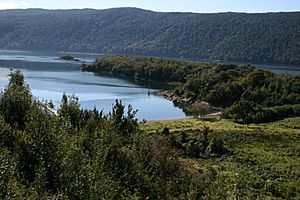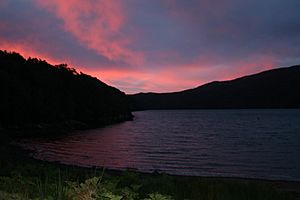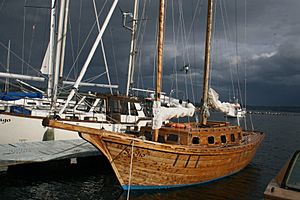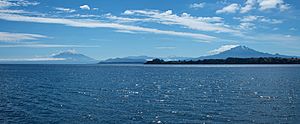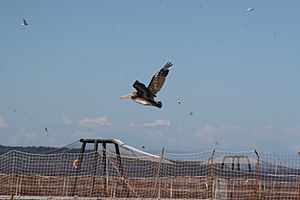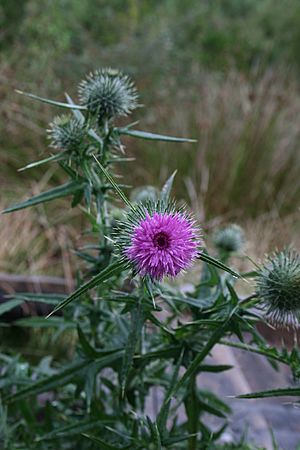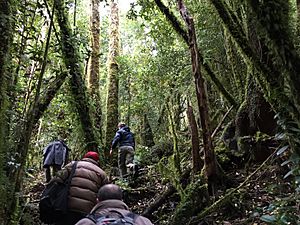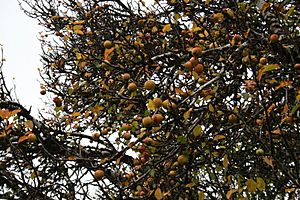San Pedro Island (Chile) facts for kids
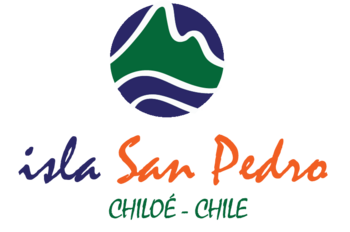 |
|
| Geography | |
|---|---|
| Coordinates | 43°21′20″S 73°44′10″W / 43.35556°S 73.73611°W |
Isla San Pedro is a special island in southern Chile. It's a private island located near the big Chiloé Island, close to a town called Quellón.
Contents
Exploring Isla San Pedro's Geography
Isla San Pedro is mostly untouched by buildings. It has about 33.46 kilometers (20.79 miles) of roads that go all around the island. These roads lead to lovely beaches. The island also has two lakes. Along the coast, you'll find tall cliffs that rise more than 500 meters (1640 feet) above the sea.
Understanding Isla San Pedro's Climate
The area around Chiloé Island has a mild climate. This means temperatures don't change too much between seasons. The western side of the island gets a lot of rain. However, the eastern side is warmer and drier. This is because it's protected by mountains, which create a "rain shadow."
The town of Quellón, near the island, has an oceanic climate. Summers are usually mild and don't get much rain. Winters are cool and wet, but still mild. February is the driest month of the year. In winter, from June to August, it rains almost every day. Snowfall is very rare on the island.
Amazing Plants and Animals of Isla San Pedro
Isla San Pedro is home to many interesting creatures. You might spot Chucao tapaculos and black-necked swans. There are also slender-billed parakeets, pelicans, and cormorants. You might even see Chilean pigeons.
The island is also where the southern pudú lives. This is the second smallest deer in the world! Many types of whales swim near the Chiloé Archipelago. These include huge blue whales and southern right whales, which are very rare. You can also see sea lions, sea otters, penguins, and dolphins from Isla San Pedro.
Charles Darwin's Visit to the Island
The famous scientist Charles Darwin visited Isla San Pedro in 1834. He wrote about his trip in his book, The Voyage of the Beagle. On the island, Darwin found the first Darwin's fox ever recorded. This fox is now very rare. He gave the fox specimen to a science group in London. Darwin also wrote about trying to climb the island's highest point. He found it hard because the forest was so thick!
Forests and Special Plants
The original forests of the Chiloé Archipelago are called Valdivian temperate rain forests. These forests have many different types of mosses and ferns. Isla San Pedro has about 16,000 acres of these thick forests. They are filled with tall hardwood trees.
Some of the trees you can find on the island include the Luma apiculata and the Ciprés de las Guaitecas (Pilgerodendron). There's also the Drimys winteri, which is a sacred tree for the Mapuche people. Other trees are the Nothofagus dombeyi and the Fitzroya cupressoides. The island also has fruit trees like apple and cherry. You can also find Chilean rhubarb, known as nalca. The first people on the island used apples to make chicha. This is a local drink, like apple cider.
The national flower of Chile, the copihue (Lapageria rosea), also grows on Isla San Pedro. You might also see purple thistles around the island.
A Glimpse into Isla San Pedro's History
The Chiloé Archipelago was first home to two main groups of people. These were the Chonos and the Huilliches. The Chonos were nomads from the south. They were great fishermen and sailors. The Huilliches were farmers. They were similar to the Mapuche people, who are native to Chile. The Chonos and Huilliches often worked together.
Whaling History on the Island
In the early 1900s, a Norwegian businessman named Christen Christensen was very interested in whaling. He wanted to set up whaling stations along the coast of South America. In 1909, his son August Christensen found a good spot on Isla San Pedro. A Norwegian company, called "Sociedad Ballenera del Pacifico" (Pacific Whaling Company), built a port there. They also built a land station called "A/S Pacific." August managed this station from 1909 until 1913. After that, whaling operations on Isla San Pedro stopped.
Old reports from that time say that the A/S Pacific company got along well with the local Chilean community. Many local people worked at the whaling station.
See also
 In Spanish: Isla San Pedro (Chiloé) para niños
In Spanish: Isla San Pedro (Chiloé) para niños


